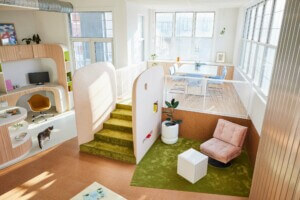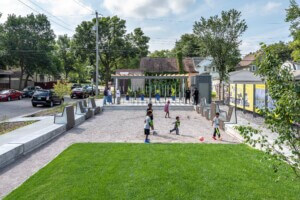The Architectural League of New York’s Emerging Voices award and lecture series highlights individuals and firms with distinct design “voices”, singling out those with the potential to go on to even greater heights.
2018 saw two rounds of judging; first by a panel of past Emerging Voices winners, and a second to pick the winners. The first-round jury included Virginia San Fratello, Sebastian Schmaling, Wonne Ickx, Lola Sheppard, Marcelo Spina, Carlos Jimenez, and Marlon Blackwell, as well as members of the second-round jury, Sunil Bald, Lisa Gray, Stella Betts, Jing Liu, Paul Makovsky, Tom Phifer, Chris Reed, and Billie Tsien.
AN profiled all of the emerging voices firms in our February print issue. Future Green founder David Seiter will deliver his lecture on March 1, 2018, at the SVA Theatre in Manhattan.
For the Brooklyn, New York–based landscape architecture firm Future Green, “spontaneous urban plants” are part of a patchwork ecology that has the potential to transform our cities. Future Green’s work is another part of that ecology.
David Seiter founded Future Green in 2008 because he felt disconnected from his work in more traditional offices, applying new landscapes onto a site when he wanted to “draw them out of the place itself.” Now grown to about 25 people, his office features a garden and 6,000-square-foot fabrication facility for prototyping new ideas and new ways of weaving contextual plantings into urban sites.
A picturesque quality pervades Future Green designs, particularly architectural collaborations like the Atlantic Plumbing residences in Washington, D.C., with Morris Adjmi Architects, and 41 Bond Street in New York, with DDG. At Atlantic Plumbing, the 300-foot-long planted window boxes contribute to the building’s postindustrial character, while the plants climbing up from 41 Bond’s facade were inspired by a visit to the quarry that provided the building’s stone. Future Green will sometimes maintain these types of projects for years after their completion to learn how the plants respond and evolve.

Nowadays, an outdoor venue on a former rubble-strewn industrial site in Queens, New York, takes an informal approach. Stepping into the 18,000-square-foot space almost feels like stepping into a friend’s backyard. It’s cultivated but not too cultivated, organized around three large earth mounds, shaded by a grid of honey locust trees that help remediate the soil, and planted throughout with weeds. “We were able to leave a lot of traditionally weed species on the site,” said Seiter, “and then we seeded in a lot of other species that are, I would say, on the edge of acceptable.” For now, Future Green is advocating for a new understanding of “native landscape” that isn’t driven by climate but by human-created conditions. The firm’s largest project to date is Half Street, a mixed-use curbless street in D.C., located near the Washington Nationals stadium. On game days, the retail-lined street closes to automotive traffic and becomes a pedestrian plaza for 30,000 people. Future Green’s design draws from its context and the need for flexibility; it includes a paving pattern inspired by Pierre L’Enfant’s iconic plan for the city, large tree pits paired with bio-swales, and other “soft” infrastructural elements designed to manage both water runoff and pedestrian traffic while creating a distinct sense of place.
Future Green’s design for Half Street reflects their belief that streets are “the foundation for good new urban space.” As Seiter said, “If we can actually design our streets and sidewalks to be more effective green spaces and more-actively designed spaces for the public realm, we can create a new garden city.”
















